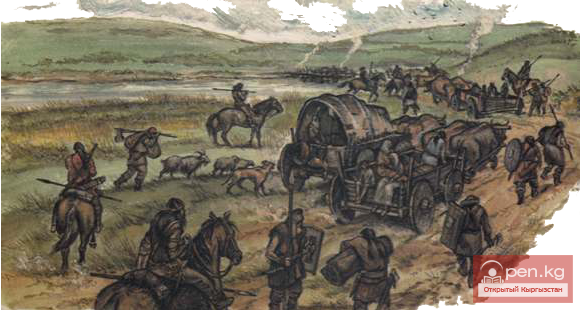
“Hudud al-Alam” on the Kyrgyz...

Arab and Persian Sources of the IX—XVII Centuries Medieval Arab and Persian authors left us very...

"Hudud al-Aalam" about the "Priirtysh" Kyrgyz...

Turks - Chigili in the "Shahnameh"...

Rashid ad-Din on the "Kyrgyz Tribe" According to Rashid ad-Din's information about...

Kyrgyz Inhabitants of the Irtysh and Altai Regions? In this case, the area of "Kyrgyz"...

«Priirtysh» Kyrgyz. In "Taba al-khayvan," Marwazi (12th century), in the section about...

«Hudud al-Alam». («Boundaries of the World»). Translation from Persian by N. Vorozheikina. This...

Turkic Beilik In the work "Hudud al-'alam," the word "Turk" appears as...

Ethnic Processes in Southern Siberia in the IX-XII Centuries After the defeat of the Uyghur...

Usy, Han-Hena, and Yilanzhou In the "Yuan-Shi," in relation to the land of the Kyrgyz,...

Muhammad Haider refers to the Kyrgyz as "the forest (wild) lions of Moghulistan." It is...

In 1123, the Chinese hermit Chan-Chun, while in the Altai region, "heard there that the...

Ancient People — Kyrgyz The Kyrgyz, whose roots go deep into antiquity, lost in the darkness of...
Curl error: Operation timed out after 120001 milliseconds with 0 bytes received...

All political entities of the Middle Ages in the territory of Central Asia somehow affected the...

First Mentions of Osh Osh is mentioned as a "city" of Fergana by the first Arab...

Ichkiliki and Arkalyki. The name "Ichkiliki" may have originated from the ancient Turkic...

Ulus Inga-Tyuri During military clashes, it appears that part of the "Central Asian"...

Balasagun One of the capitals of the Karakhanid state was the city of Balasagun, located in the...

The ethnonyms “Turk” and “Turkut” were first mentioned in a Chinese chronicle from the year 546....

“The Kyrgyz Tribe Named Itself Oghuz-Khan” The clan-tribal structure of the Kyrgyz of the right...

The Infiltration of Yenisei Kyrgyz into the Tian Shan Our task is to examine the issues regarding...

Gyan-gun and Dinlins In the sources of the 1st-2nd centuries AD, the gyan-gun are not mentioned,...

Protoichkiliks and Arka These accounts may refer to the separation of a certain part of the tribes...

Ethnocultural Connections Between the Kyrgyz and the Kipchaks The significance and political role...

Kyrgyz K. A. Pishulina rightly points out that only those tribes and clans that participated in...

Karluks...

The Conquest of the Kyrgyz by Russia. In the last quarter of the 18th century, the southern tribes...

Kyrgyz-Gyangu The earliest mention of the Kyrgyz under the Chinese name “gyan-gun”, “heguni”, or...

Kyrgyz in Kazakhstan. Small groups of ethnic Kyrgyz have found themselves in various parts of...

Legends. In the first half of the 12th century, it is likely that the "Karakhanid"...

The Influence of Islam on Kyrgyz Rituals On the map of the Liao era (916—1125) and Northern Song...

The Karakhanid Kingdom...

A. G. Malyavkin. Historical Geography of Central Asia. Novosibirsk, 1981 "Jiu Tanshu"...

The formation of the Kyrgyz people is connected with ethnic processes in ancient and medieval...

The Important Political Role of the Kyrgyz in Fergana at the End of the 18th Century With the...

Magical Hours. New Year Tree A large show program for children aged 5-12 Winter – Meeting...

The Toguz Bulak ski resort is located at an altitude of 2300 meters above sea level, 44 km from the...

The forge of the zergers. Mid-19th century. The photo is kept in the State Historical Museum...

Facts Supporting the Statement of Prominent Soviet Ethnographer and Kyrgyz Scholar S. M. Abramzon...

In the final of the Toguz Korgool among women's teams, the teams of Kyrgyzstan-1 and...
[img]http://vesti.kg/dаta:image/svg+xml;base64,PHN2ZyB4bWxucz0iaHR0cDovL3d3dy53My5vcmcvMjAwM...

Writings of "Shajarat al-Atrak" In the anonymous work "Shajarat al-Atrak,"...

Rashid ad-Din. Collection of Chronicles. Vol. I. M.-L., 1952 Rashid ad-Din (1247—1318) was the...

Population of Kyrgyzstan Thanks to the fundamental changes that occurred in Kyrgyzstan after the...